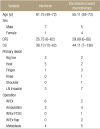Abstract
Purpose
Immunotherapy of malignant melanoma using Interferon-α2b increases the adaptive immune system activity remaining after surgical resection of the tumor to prevent recurrence, and enhance survival. We will compare the therapeutic effect upon disease-free survival, and overall survival of immunotherapy using high-dose interferon-α2b versus combination therapy using the same regimen with additional dacarbazine after surgical resection.
Materials and Methods
At Kosin University Gospel Hospital, from March, 2003 to July, 2014, 17 patients underwent postoperative adjuvant therapy after being diagnosed with malignant melanoma. Of the 17 patients, eight underwent immunotherapy using interferon and nine underwent combination therapy using interferon with dacarbazine. Average of 29 months in the immunotherapy group and 44 months for the control group.
Results
Of patients receiving interferon-α2b immunotherapy, four patients showed no evidence of local recurrence and local/distant metastasis, two developed local recurrence and metastasis, and two developed distant metastasis. Of those who underwent combination therapy using interferon with dacarbazine, three patients showed no evidence of local recurrence or metastasis, four developed local recurrence and metastasis, and two developed distant metastasis. The average disease-free survival was 25.75 months with interferon therapy and 29.89 months with dacarbazine therapy. The survival difference between the anticancer therapies was not statically significant based on Kaplan-Meier survival.
Figures and Tables
 | Figure 1We analyzed the difference in disease free survival (DFS) between interferon and dacarbazine (DTIC) using survival analysis, and the result was not statistically significant (p=0.884). |
References
1. Gray RJ, Pockaj BA, Kirkwood JM. An update on adjuvant interferon for melanoma. Cancer Control. 2002; 9:16–21.

2. Rigel DS, Carucci JA. Malignant melanoma: prevention, early detection, and treatment in the 21st century. CA Cancer J Clin. 2000; 50:215–236.

3. Booher RJ, Pack GT. Malignant melanoma of the feet and hands. Surgery. 1957; 42:1085–1121.
4. Ferlay J, Bray F, Pisani P, Parkin DM. Globocan 2000: cancer incidence, mortality and prevalence worldwide, version 1.0. IARC CancerBase No. 5. Lyon: IARC Press;2001.
5. Katz RD, Potter GK, Slutskiy PZ, Smith RR, Pfau RG, Berlin SJ. A statistical survey of melanomas of the foot. J Am Acad Dermatol. 1993; 28:1008–1011.

7. Verma S, Quirt I, McCready D, Bak K, Charette M, Iscoe N. Systematic review of systemic adjuvant therapy for patients at high risk for recurrent melanoma. Cancer. 2006; 106:1431–1442.

8. Lee JL, Kim YH, Lee JM, Kim JD, Kim SJ, Park JH. Molecular analysis of HLA-DR gene expression induced by IFN-gamma in malignant melanoma cell lines. Yonsei Med J. 1999; 40:30–39.

9. Isaacs A, Lindenmann J. Virus interference. I. The interferon. Proc R Soc Lond B Biol Sci. 1957; 147:258–267.
11. Kleeberg UR, Bröcker EB, Lejeune F, et al. Adjuvant trial in melanoma patients comparing rIFN-alpha to rIFN-gamma to Iscador to a control group after curative resection of high risk primary (≥3 mm) or regional lymphnode metastasis (EORTC 18871). Eur J Cancer. 1999; 35:S82.
12. Kirkwood JM, Strawderman MH, Ernstoff MS, Smith TJ, Borden EC, Blum RH. Interferon alfa-2b adjuvant therapy of high-risk resected cutaneous melanoma: the Eastern Cooperative Oncology Group Trial EST 1684. J Clin Oncol. 1996; 14:7–17.

13. Kirkwood JM, Ibrahim JG, Sondak VK, et al. High- and low-dose interferon alfa-2b in high-risk melanoma: first analysis of intergroup trial E1690/S9111/C9190. J Clin Oncol. 2000; 18:2444–2458.

14. Cole BF, Gelber RD, Kirkwood JM, Goldhirsch A, Barylak E, Borden E. Quality-of-life-adjusted survival analysis of interferon alfa-2b adjuvant treatment of high-risk resected cutaneous melanoma: an Eastern Cooperative Oncology Group study. J Clin Oncol. 1996; 14:2666–2673.

15. Eggermont AMM, Kleeberg UR, Ruiter DJ, Suciu S. The European Organization for Research and Treatment of Cancer Melanoma Group trial experience with more than 2000 patients, evaluating adjuvant therapy treatment with low or intermediate doses of interferon alpha-2b. In : Perry MC, editor. American Society of Clinical Oncology. American Society of Clinical Oncology educational book. Alexandria (VA): American Society of Clinical Oncology;2001. p. 88–93.




 PDF
PDF ePub
ePub Citation
Citation Print
Print




 XML Download
XML Download